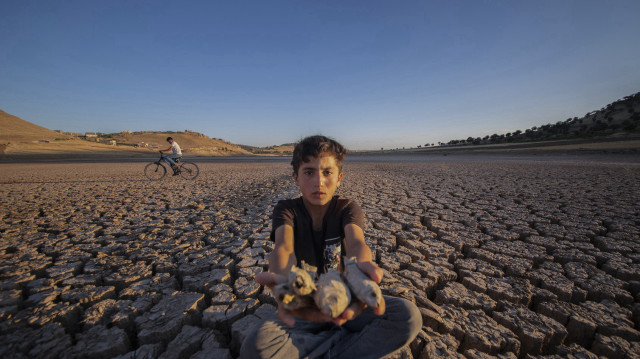
Climate change is not limited to global warming and rising sea levels; it also brings along water crises that directly impact urban life. Rising temperatures, shifting precipitation patterns, and extreme drought conditions compel a rethinking of urban water management. In Turkey, the effects of this process are becoming increasingly visible. Most recently, Kocaeli Metropolitan Municipality announced that dam water levels have dropped to critical levels and that planned water cuts may be implemented starting in October—underscoring the seriousness of the situation. Similarly, the district of Çeşme in İzmir is also facing a severe water shortage crisis. These developments highlight that water is no longer merely a natural resource but has become a strategic element.
Globally, the diminishing availability of freshwater resources due to climate change is creating a more pronounced crisis in densely populated urban centers. According to the World Wide Fund for Nature (WWF), around 40% of the world’s population lives under water stress. United Nations projections suggest that by 2050, more than 60% of the world’s population will reside in areas prone to water scarcity. As water resources decline while urban populations and water demand increase, water has become a complex, multi-actor issue.
Turkey is not a water-rich country. With an annual per capita water availability between 1,000 and 1,700 cubic meters, Turkey is technically classified among the countries experiencing water stress. This stress is especially evident in the Marmara, Aegean, and Central Anatolia regions. In the case of Kocaeli, the high concentration of industrial facilities, population growth, and unplanned urbanization place tremendous pressure on water resources. While infrastructure investments, water treatment facilities, and leakage reduction projects by municipalities are significant, they remain insufficient.
The recent warning by Kocaeli Metropolitan Municipality is a clear indicator of this reality. If high temperatures persist and rainfall remains absent, water cuts may begin in October. This situation reveals the urgent need for not only addressing supply but also developing a comprehensive strategy for the equitable and efficient use of water. A similar scenario is unfolding in Çeşme, a touristic district in İzmir whose population multiplies during summer. One of the main dams supplying the district, the Gördes Dam, has completely dried up, and the Tahtalı Dam is reported to be nearing critical levels.
Cities that have developed successful strategies against the global water crisis can serve as models for Turkey. Urban responses to water crises in different parts of the world show how water management strategies diversify and adapt based on local contexts. Cape Town offers an example of managing a crisis through radical water consumption restrictions, behavioral changes, and urgent technical solutions such as recycling and seawater desalination. In contrast, Singapore has adopted a long-term, planned approach through its “Four National Taps” strategy, establishing a diversified water supply system that integrates technology, public transparency, and a culture of water conservation.
Similarly, Barcelona has implemented a preventive strategy centered on digitalization, using smart systems to monitor and manage water in real time. Melbourne has combined technical measures with community-based behavioral change policies—such as the Target 155 campaign—achieving long-term cultural transformation in water use. Los Angeles, in its fight against drought, has reimagined urban design with xeriscaping, greywater incentives, and IoT sensors, integrating water into urban life while also reducing the urban heat island effect.
As a megacity prone to disasters, Tokyo has developed a multilayered water security model that integrates water supply with disaster resilience. Its water infrastructure is designed to withstand earthquakes and is supported by innovative solutions such as mandatory rainwater harvesting. Copenhagen stands out with nature-based solutions, building a resilient urban ecosystem against both drought and flooding, and making water an integral part of the urban landscape through green-blue infrastructure.
Lastly, São Paulo has shown that the water crisis is not just a resource management issue but also a matter of social justice and governance. Inequities in water distribution, lack of information, and diminished public trust have demonstrated that technical solutions are unsustainable without social legitimacy.
All these examples illustrate that successful urban water management does not rely solely on engineering solutions but also requires multidimensional strategies including political will, public participation, social equity, and planning in harmony with nature. Policies developed to counter urban water crises must be sensitive to local conditions while also drawing lessons from global experiences.
The recent water crises in cities like Kocaeli and İzmir reveal the fragility of Turkey’s urban water policies and the need for their restructuring. In this restructuring process, strategies focused on reducing water demand should be prioritized. Rainwater harvesting systems and infrastructure enabling greywater use should be promoted, and such systems should be made mandatory in new housing and collective living projects. This would facilitate a transition from the linear model—where water is used once and discarded—to a circular system in which water is reused.
On the other hand, Turkey’s water loss and leakage rates, averaging around 40%, are well above global standards. In OECD countries, this figure is typically below 10%. This indicates significant inefficiencies in water management stemming from shortcomings in technical infrastructure. Reducing losses through smart meters, pressure management technologies, and systematic maintenance will enable more efficient use of existing resources.
Water management must be strengthened not only technically but also administratively. Local governments should actively include universities, civil society organizations, and the private sector in decision-making processes, thereby contributing to a more participatory and scientifically grounded governance structure. In the face of complex challenges like the climate crisis, interdisciplinary approaches to water strategy development will increase cities’ resilience.
Furthermore, urban planning must be rethought in alignment with climate change. Preventing construction in water basins, reducing impervious surfaces, and protecting natural ecosystems that retain water are essential to preserving the urban water cycle. Alongside these technical and institutional measures, it is also crucial that citizens participate in water management processes as informed and responsible individuals. Promoting a culture of water conservation requires not only a change in individual consumption habits but also a transformation in social behavior. Therefore, municipalities, media organizations, and educational institutions should conduct long-term awareness campaigns to ensure that the value of water is remembered in all aspects of daily life.
In conclusion, the effects of climate change on cities are no longer a prediction for the future—they are an urgent reality of today. The recent developments in Kocaeli and İzmir exemplify how this reality is manifesting in Turkey. To mitigate the impact of the water crisis, holistic, participatory, and technology-based solutions at the urban scale are of vital importance. The experiences of global cities show us that water is not merely an infrastructure issue—it is a matter of planning, governance, and culture. In this context, it is imperative for local governments in Turkey to adopt a more resilient and sustainable approach to water management.
*Burak Kaplan completed his undergraduate studies in Political Science and Public Administration, his master’s degree in Public Policy, and his PhD in Local Governments and Urban Policies. He conducts scientific research on urban and environmental issues.







